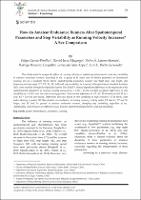Por favor, use este identificador para citar o enlazar este ítem:
https://repositorio.usj.es/handle/123456789/387
Registro completo de metadatos
| Campo DC | Valor | Lengua/Idioma |
|---|---|---|
| dc.contributor.author | García-Pinillos, Felipe | - |
| dc.contributor.author | Jerez-Mayorga, Daniel | - |
| dc.contributor.author | Latorre-Román, Pedro Á. | - |
| dc.contributor.author | Ramirez-Campillo, Rodrigo | - |
| dc.contributor.author | Sanz-López, Fernando | - |
| dc.contributor.author | Roche-Seruendo, Luis Enrique | - |
| dc.date.accessioned | 2020-06-08T09:13:37Z | - |
| dc.date.available | 2020-06-08T09:13:37Z | - |
| dc.date.issued | 2020-04 | - |
| dc.identifier.citation | García-Pinillos, F., Jerez-Mayorga, D., Latorre-Román, P.Á., Ramirez-Campillo, R., Sanz-López, F., Roche-Seruendo, L.E., 2020. How do Amateur Endurance Runners Alter Spatiotemporal Parameters and Step Variability as Running Velocity Increases? A Sex Comparison. Journal of Human Kinetics.. doi:10.2478/hukin-2019-0098 | es_ES |
| dc.identifier.issn | 1640-5544 | es_ES |
| dc.identifier.uri | https://repositorio.usj.es/handle/123456789/387 | - |
| dc.description | This study aimed to analyse the effects of running velocity on spatiotemporal parameters and step variability in amateur endurance runners, according to sex. A group of 51 males and 46 females performed an incremental running test on a treadmill (10-16 km/h). Spatiotemporal parameters (contact and flight time, step length, step frequency and step angle [CT, FT, SL, SF, SA]) and step variability, in terms of within-participant standard deviation (SD), were recorded through the OptoGait System. The ANOVA showed significant differences in the magnitude of the spatiotemporal parameters as running velocity increased (p < 0.001). It also revealed significant differences in step variability (p < 0.005) over the entire running protocol. Between-sex differences in CT, SL, SL-normalized and SF (p < 0.05, ES = 0.4-0.8) were found. Differences were also found in step variability at high velocities (15-16 km/h), with males showing a greater SD than females. In conclusion, increasing running velocity makes CT shorter, FT and SL longer, and SF and SA greater in amateur endurance runners, changing step variability, regardless of sex. Additionally, some between-sex differences were found in spatiotemporal parameters and step variability. | es_ES |
| dc.format.mimetype | application/pdf | es_ES |
| dc.language.iso | eng | es_ES |
| dc.publisher | Sciendo | es_ES |
| dc.rights | Atribución 4.0 Internacional | * |
| dc.rights.uri | http://creativecommons.org/licenses/by/4.0/ | * |
| dc.subject | Género | es_ES |
| dc.subject | Biomecánica | es_ES |
| dc.subject | Cinemática | es_ES |
| dc.subject | Carrera | es_ES |
| dc.title | How do Amateur Endurance Runners Alter Spatiotemporal Parameters and Step Variability as Running Velocity Increases? A Sex Comparison | es_ES |
| dc.type | info:eu-repo/semantics/article | es_ES |
| dc.subject.unesco | Desarrollo de la carrera | es_ES |
| dc.identifier.publicationfirstpage | 39 | es_ES |
| dc.identifier.publicationlastpage | 49 | es_ES |
| dc.identifier.doi | 10.2478/hukin-2019-0098 | es_ES |
| dc.rights.accessrights | info:eu-repo/semantics/openAccess | es_ES |
| Aparece en las colecciones: | Artículos de revistas | |
Ficheros en este ítem:
| Fichero | Descripción | Tamaño | Formato | |
|---|---|---|---|---|
| How do Amateur.pdf | 427,96 kB | Adobe PDF |  Visualizar/Abrir |
Este ítem está sujeto a una licencia Creative Commons Licencia Creative Commons

